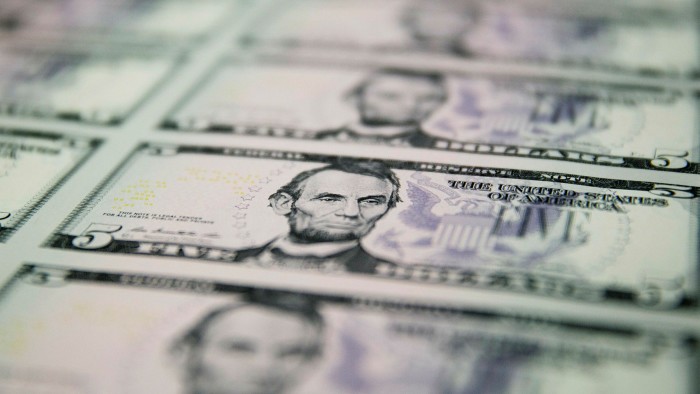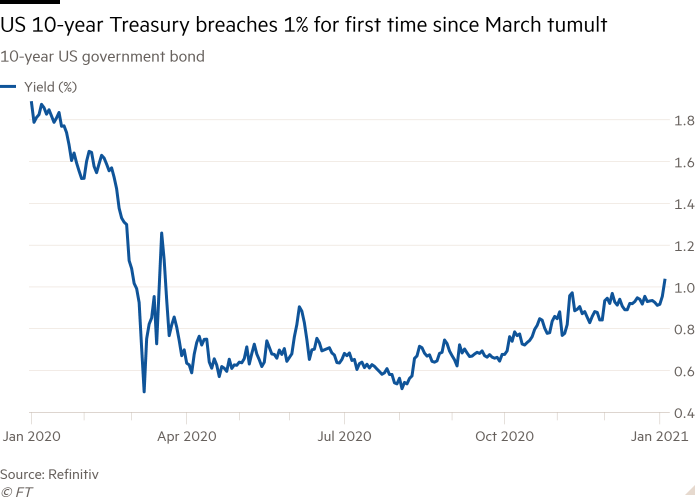US government bonds sink on Georgia reflation bet

Roula Khalaf, Editor of the FT, selects her favourite stories in this weekly newsletter.
US government bond prices dropped to their lowest point since the start of the coronavirus crisis on Wednesday as investors bet that Democrats were poised to capture the Senate and clear the way for a larger stimulus package that could fuel economic growth and inflation.
Government bond prices in the US and around the world fell as Raphael Warnock won one of two US Senate run-off elections in Georgia and his Democratic colleague John Ossoff led in the other, pushing the 10-year benchmark yield above 1 per cent — its highest level in more than nine months.
Victories in both Georgia Senate races would give Democrats and senators who vote alongside the party 50 seats in the upper chamber, which along with the tiebreaking vote held by the vice-president would put them in control of both houses of Congress and the White House. Control of the Senate could allow president-elect Joe Biden to push a bigger fiscal stimulus through Congress than the $900bn programme already passed in December.
“We’ve already had a short-term fiscal package to shore up the recovery, now the market is expecting something much larger and longer lasting,” said Antoine Bouvet, a senior rates strategist at ING. “You’re likely to see more money for infrastructure, more money for households. It’s unambiguously positive for growth.”
The yield on the 10-year Treasury note fell below 1 per cent for the first time in history last March when the coronavirus pandemic induced a rush to safety and it has largely stayed there since in anticipation of long-running drab growth. But by morning trading in the US on Wednesday, it had pushed 0.09 percentage points higher at 1.05 per cent, dragging yields higher in other government bond markets. Yields rise as prices fall.
The possibility of additional stimulus under a Biden administration and Democrat-controlled Congress — a so-called blue wave — has buoyed investor sentiment even as the US confronts a wave of coronavirus cases and continuing economic malaise before a vaccine is available to most Americans.

One market measure of inflation expectations over the next decade has risen accordingly. The 10-year break-even rate, which is derived from prices of US inflation-protected government securities, breached 2 per cent this week — a level last reached in late 2018.
Low bond yields have helped support rising valuations in the $42tn US equity market and a reversal could weigh on share prices. Futures trading pointed to a slide in the value of tech stocks — which have been propelled by rock-bottom rates — when markets open on Wednesday.
The Federal Reserve responded to last year’s crisis by slashing interest rates to zero and pledging to buy an unlimited quantity of US government debt.
Those actions, coupled with the unprecedented economic contraction caused by coronavirus-related lockdowns, suppressed yields and drastically cut the government’s borrowing costs even as it sold a record amount of new Treasuries to fund stimulus packages passed by Congress.
Many strategists foresee the benchmark Treasury yield rising as high as 1.24 per cent this year, according to Bloomberg data, but it is likely to struggle to sustainably trade above that level.
Mark Dowding, chief investment officer at BlueBay Asset Management, said he has been betting against long-dated Treasuries yields in recent weeks, but thinks the move is mostly played out. The presence of the Fed should keep a lid on yields, while the wafer-thin Senate majority will allow moderate Democrats to curb any of Mr Biden’s more radical policy shifts.
“This is more of a blue ripple than a blue wave,” Mr Dowding said. The 10-year Treasury yield could rise by another 0.1 percentage points in the coming weeks, but “that’s when you want to take profits” by buying Treasuries, he added.
Comments